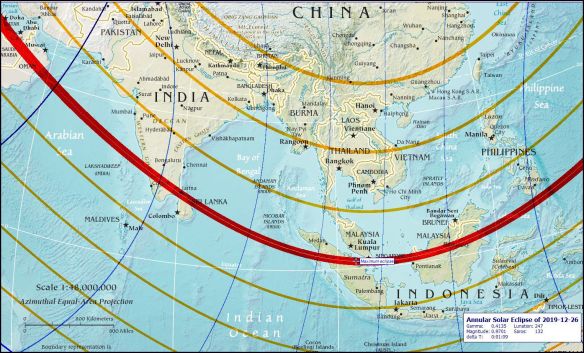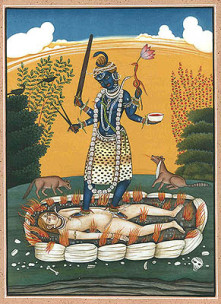I became aware of this upcoming eclipse quite some time ago. It caught my attention because the point of greatest eclipse is over Singapore, within a nexus of volcanoes and frequent seismic activity and of course the date echoes that of the massive tsunami in the Indian Ocean on Boxing Day, 2004 believed to be the deadliest tsunami in history, with a death toll in excess of 230,000 people in 14 countries.
It began at 7:59am local time on December 26, 2004, when a 9.1-magnitude quake struck off the northern tip of Sumatra in Indonesia, reminding us all that this region is extremely volatile. In fact, it was at the site of present-day Lake Toba in Sumatra, Indonesia. that the extinction level super volcano killed off all but about 10,000 human beings about 70,00 years ago.
The upcoming eclipse is .3 minutes and 40 seconds in duration, affording a window of more than two and a half years of influence, but that doesn’t mean that we would have to wait that long for results, particularly considering. the larger pallet of celestial events, not least of which is the momentous Superior Conjunction of 2020 12 Dec 2020.
The chart for the eclipse is, of course, diurnal, the Planetary Day is Jupiter, the Hour belongs to Saturn who is also the Almuten. Mercury is Matutine Waning, Venus is Vespertine Waxing. No planets are in their Joy. Significantly, the Hyleg is the Sun – this evokes an image of the life force being diminished at the time of the eclipse. Five planets and luminary are deposited by Saturn and Saturn’s reach extends to Mars in his own domicile with his exaltation in Capricorn. Importantly, the Sun in Capricorn is in aversion to his domicile. The N. Node in the fourth house.gives us the image of the ‘end of things’ as well as earth and its roots.
The Greater Malefic is unleashed. Saturn is the key player for this eclipse and even more so for the upcoming Conjunction.
 There is a crucial element that might be missed by many astrologers using the tropical zodiac exclusively. The Eclipse occurs in the Moola (Mula. )nakshatra, which is the 19th nakshatra or Lunar Mansion.
There is a crucial element that might be missed by many astrologers using the tropical zodiac exclusively. The Eclipse occurs in the Moola (Mula. )nakshatra, which is the 19th nakshatra or Lunar Mansion.
Each of 27 (or, according to some texts, 28) equal divisions of the ecliptic through which the moon passes during the course of a sidereal month; a lunar mansion; the period of time with which each of these corresponds. In Sanskrit, nakṣatra means star, lunar mansion (lit. ‘with dominion overnight’) from nak, nakt- + kṣatra dominion See (OUP)
The significance of ‘Moola’ is root and its symbol is a bundled bunch of roots tied together. Moola nakshatra is ruled by the Goddess of destruction, i.e. Goddess Maha Kali. – sharp or dreadful. Ketu is also attributed to the nakshatra.; writes: “The planets and luminaries Mula Nakshatra is the first Nakshatra of the third (and final) Sattva group of nine Nakshatras, and it arises out of the very difficult Abhukta Mula Gandanta Zone: 2 deg either side of the transition from the sign before: Jyestha, to this Nakshatra: Mula.” See https://blog.starwheelastrology.com/
This is an obvious potential pitfall of using the Tropical zodiac which is oriented to the Solstices and Equinoxes The sidereal zodiac is fixed and based on the position of stars and the Moon. So, when we draw up a chart using Tropical, the nakshatras will, of course, remain in the same place, but do not appear to belong to the signs and asterisms from which they were derived. So, we have the odd situation of a planet in the early degrees of tropical Capricorn, whilst the sidereal charts place it in the early degrees of Sagittarius. This is the case in this chart. Moola is the galactic centre in Sagittarius ad to miss this is to lose much valuable information. In my own view, the nakshatras are too important to ignore.
Saturn itself, however, is in the 22nd nakshatra, Shiravan Chandra (Moon) owns this Nakshatra. This constellation spans from 10°00′ to 23°20′ in Makara, owned by the Shani (Saturn).
See the chart below, calculated using the Fagen-Allan zodiac.
It is becoming increasingly apparent that astrologers such as Vettius Valens and those before him used a sidereal (Babylonian) zodiac and sometimes in concert with a Tropical zodiac. Of course, for some time, the two systems would have yielded similar results. It would see that the exclusive use of the tropical zodiac came into being either by or through Ptolemy. We are now seeing more clearly how the Indian, Persian and Hellenistic astrological traditions influenced each other. An increasing number of contemporary traditional astrologers have taken it upon themselves to discover what can be gained by knowledge of Indian and Persian astrology.
Having said that, the reading of the tropical chart for this event provides a great deal of information and could be used as a stand-alone chart. However, we would miss some extremely important elements in the process.
There is no denying that this a difficult configuration for the eclipse. We also find a strong Mars in the House of Death. Volcanoes and seismic shifts are notoriously difficult to predict, but with this chart, I think it would be wise to take careful note and do whatever needs to be done to minimize the loss of life The magnitude is uncertain, but it will be a highly significant impact that by no means will go unnoticed. By including recognition and analysis of the nakshatra, we are given deeper insight into the nature of the event.
The following video of the last eruption of Krakatoa was taken by Martin Rietze, who retains Full Credits.










